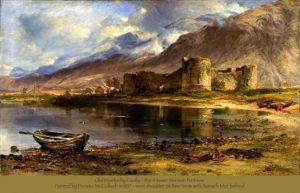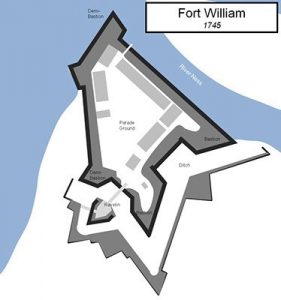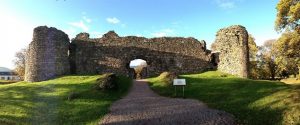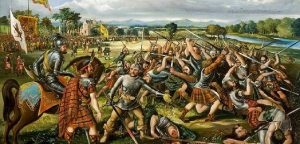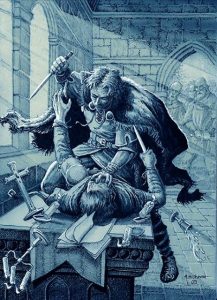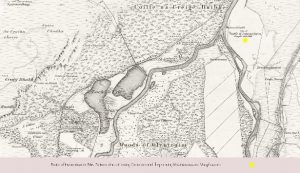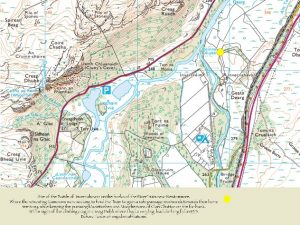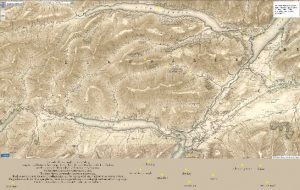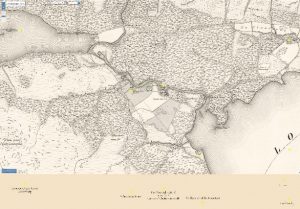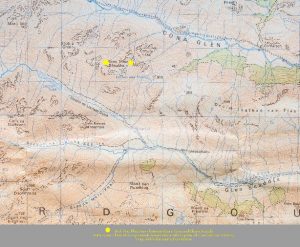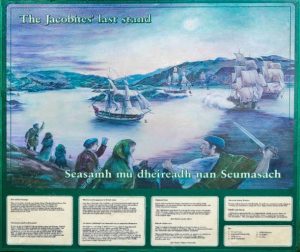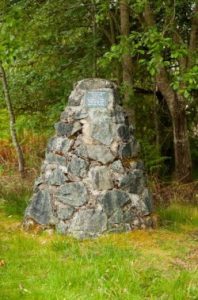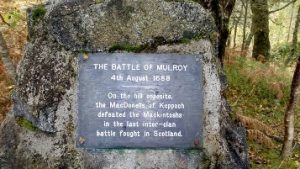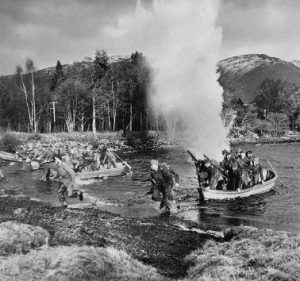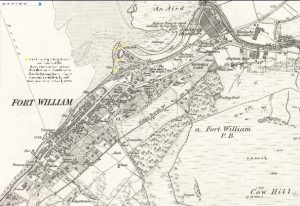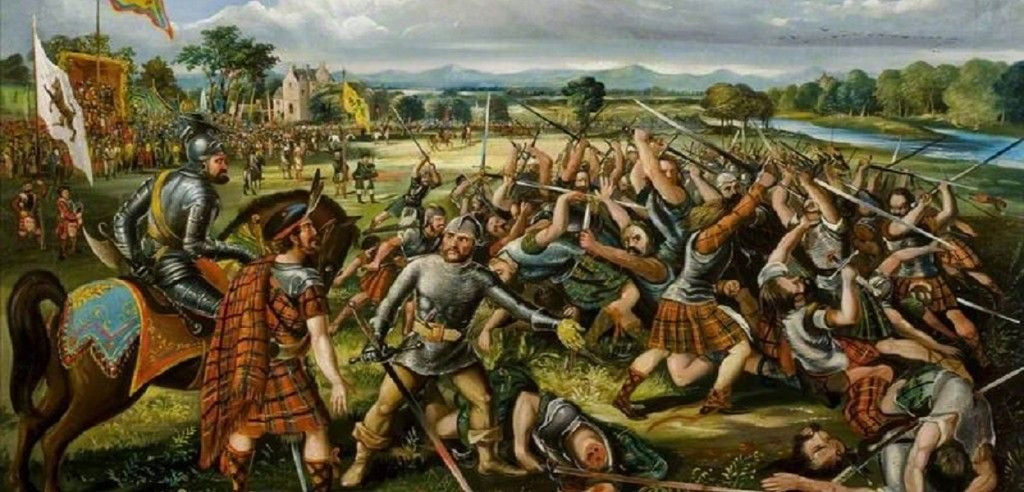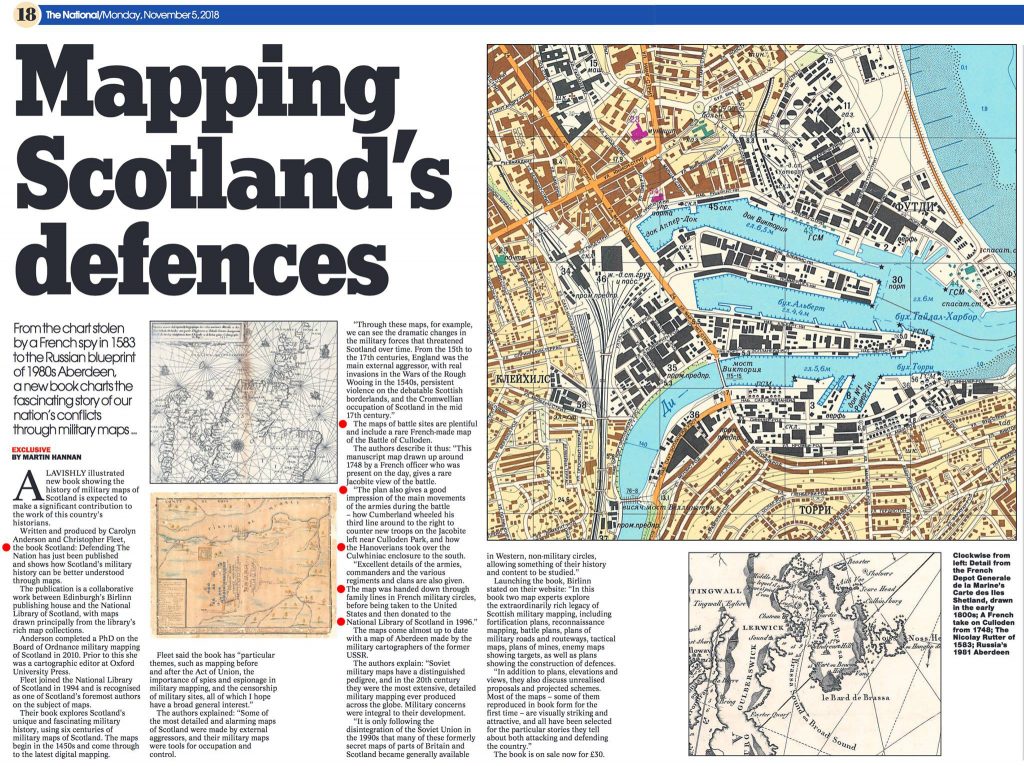Inverlochy Castle and Achnacarry
A summary of Clan Cameron and repeated raiding led by the Macintosh.
Inverlochy Castle (Inbhirlochie) was built in the 1200s by the Comyns of Badenoch. There is a legend it was sited on the remains of a Pictish fort dating back at least a further five hundred years. The Comyn estate here extended to Glen Loy and Loch Arkaig and through to the disputed west coast margins. It was a frontier against the intentions of the Lords of the Isles, and the northern clans near Inverness with a traditional fealty to the Mormaers and Earls of Moray, and clans such as the Macintoshes and eventually Clan Chattan.
Inverlochy Castle when built by the Comyns was a bastion against the Lord of the Isles as well as unfriendly and avaricious neighbours. To the north the province of Moray’s importance as part of the kingdom of Scotland was demonstrated during the years of major warfare between 1296 and 1340. The province was relatively untouched by direct fighting and Royal led English armies penetrated Moray on only three occasions in 1296, 1303 and 1335, and significant English occupation occurred only in 1296–97. Read More
This security meant that it was a vital refuge and recruitment ground for the Scottish guardians between 1297 and 1303, and provided Robert I of Scotland with a base and allies during his northern campaign against the Comyns and their allies in 1307–08. The province was forced to submit to Edward I of England in 1303 and Robert I of Scotland therefore clearly recognised the significance of Moray for the security of his realm. In 1312 Robert I re-established the Earldom of Moray for his nephew, Thomas Randolph, 1st Earl of Moray. The new earldom included all of the old province and the crown lands of the Laich or coastal area of Moray. Thomas’s son John Randolph was killed in 1346, leaving no heir and the other noble families including the Comyns, Strathbogies and Morays had all disappeared from or left the province by between 1300 and 1350.
With the absence of noble leaders, power fell to lesser figures who functioned in kin-based groups such as the Clan Donnachaidh of Atholl and the Chattan Confederation which centred on Badenoch. This drew in lords and men from outside of the province, from further south such as the Dunbars and Stewarts who staked their claims. In 1372, the Earldom of Moray was divided between them with John Dunbar receiving the coastal districts and Alexander Stewart, favourite son of Robert II of Scotland being made lord of Badenoch in the uplands. The division of Moray led to local conflict which was exacerbated by the activities of local kindreds and the eastward spread of the Gaelic superpower, the Lord of the Isles.
The activities of the Isles-men, and the kindreds in the service of Alexander Stewart made Moray the area of greatest conflict between the revived power of Gaelic Scotland and the structured society under the crown established during the previous centuries. Churchmen and burgesses made repeated complaints about the attacks of raiding caterans, the most notable being the burning of Elgin Cathedral by Alexander Stewart, Earl of Buchan, based at Lochindorb, also known as the Wolf of Badenoch, in a dispute with the Bishop of Moray.
The strategic value of a fort at Inverlochy was to guard access against attack from the sea to the Glen Glen leading to Inverness and the lands of Moray, and the straths that opened to east from Spean Bridge towards Laggan, Dalwhinnie and the Badenoch, also held for the King but dependent on the wavering loyalties of the clan confederations such as Chattan. Centred on an unofficial frontier in the area of Laggan was one of the flash points between the clans of Chattan and the Camerons and the Comyns before them – all disputatious relatively minor regional leaders in the greater scheme of holding the early Scots nation together.
When the MacBeans of Kinkyle, Faille and Tomatin received the titles to lands, this came from their feudal overlord Campbell of Calder (Cawdor). The overwhelming debts of Paul MacBean 12th Chieftain caused an interruption in the payment of feu fees in about 1685. However, the lands were re-granted in the same year by the Earl of Cawdor to Paul’s son William MacBean 13th, ‘in Kinkyle’. William’s elder son Aeneas MacBean 14th succeeded him, followed by Aeneas’s nephew Captain Donald MacBean 15th, son of his younger brother Gillies MacBean, who became famous as a result of his exploits at Culloden.
The Campbell of Cawdor has disposed of immediate control of much of his lands, as he was in effect bankrupt having been involved an extremely costly dispute concerning the violent dispossession of the inhabitants of Islay in favour of Clan Campbell. So the MacBeans gained their titles in order to swell the coffers of Campbell. A certain element of loyalty to the cause would have been intended, and this makes things difficult at the clan superiors, the Macintoshes were frequently at the throats of the Campbells over the years. But the MacBeans owed title of their lands to Campbells, who lived very uneasily with Chattan Macintoshes as their immediate neighbours. It is likely that the Campbells of Calder were originally Norman as early records refer to them as ‘de Cadalla’.
One should note the Earls of Huntly were Gordons. George Gordon 4th Earl of Huntly joined the controlling committee of the Lords of the Congregation in 1560 and was prepared to accept Mary, Queen of Scots, until she transferred the Earldom of Moray, which had been given to the Earl of Huntly in 1549, to her half-brother Lord James Stewart, at which point he withdrew to his estates in the North-East of Scotland. Could it possibly ever become any more complex? The answer at local level concerning Chattan and Cameron is , yes!
There has to be a mention at this point of Mac Bethad mac Findláich, (Macbeth). He ruled Scotland from 1040 to 1057, after his forces killed King Duncan I in battle near Elgin. Macbeth was never Thane of Cawdor, this being an invention of the 15th-century writer Hector Boece. However he was the Mormaer of Moray. Moreover, Cawdor Castle did not exist during the lifetimes of Macbeth or Duncan, and it is never explicitly mentioned in the play. The 5th Earl Cawdor is quoted as saying, “I wish the Bard had never written his damned play!” Similarly the occasionally suggested family connection between Macbeth and MacBean holds absolutely no verification and seems at best mere and fanciful.
Meanwhile, and before, the Inverlochy fort had taken many forms. Initially probably a ring ditch with pallisading formed an elaborated by the Picts around 500 AD, of which nothing survives. Then the first stone structure built by the Comyns in the Norman style on a square floor plan with four corner towers. This fell
into serious disrepair so was superseded by new fortifications on a new and close by site, in timber, associated with the Cromwellian Roundheads of General Monck. This was built over to create the most substantial of the structures the forts involved in the 1715 and 1745 Jacobite uprisings. the Government had been shaken by this violent rebellion and in 1690 and a lot of money went into reinforcing what would become garrisons.
The new facility was raised by General Mackay and he named it Fort William after the new King. It was much larger than the earlier structure and was intended to garrison up to1,000 men as well as having fifteen 12- pounder guns. Work started on this earth and timber fortification around 1690 and it was rebuilt in stone in 1698. The new fort was built on top of the earlier Cromwellian structure and had an irregular layout. Its north- east wall abutted the River Ness and was protected by a demi-bastion. The southern landward sides were fronted by a zigzag ditch shaped by two bastions. The north-west side was protected by a demi-bastion and boggy ground lay beyond. A riveted glacis protected the east and southern sides of the fort whilst the entrance was via a ravelin. A ravelin is a triangular structure that divides attackers and exposes them to deadly flanking fire. It was first used as a fortification structure in Italy in the late 1400s. A small settlement grew up outside the walls that became known as Maryburgh after Queen Mary. This was the first settlement at this location. It is now called Fort William.
Following the advent of cannon, and because the earlier forts were built to withstand lightly armed forces from the sea, they were eventually poorly thought of as defensive centres. But despite being very soundly raked with Jacobite cannon fire from four batteries placed to overlook them on Cow Hill, the defenders of the Hanoverian fort at Inverlochy were the only garrison that was attacked, not to surrender in the 1745 uprising. It was besieged for 5 weeks. The reason it was able to hold out was its formidable structure and the ability to resupply it from the sea.
Donald Bane of Inverness, perhaps a MacBean, known as ‘the Swordsman’, the impressively fortunate, skilled solder, and rascallion, who famously vaulted the gorge at Killecrankie, fought in sixteen battles and present at 52 sieges, completed his military career as the ‘Cannonier’ at Fort William. He does not mention serving there in a time of conflict. His life span was 1664 until at least 1728 when his book was first
published. His last conflict as an enlisted soldier appears to have been in Flanders in 1712. My guess is that was present at Fort William after the cessation of hostilities against the Jacobites in 1719.
The ancient Comyn castle which is now mostly ruined is located on the banks of the River Lochy, signposted a short distance from the A82 road. It became the site of the murder of the untrustworthy Ewen Cameron of Erracht by the followers of Donald Taillear Dubh na Tuaighe Cameron. An instrumental event in the return of Allan Cameron, 16th Chief of Clan Cameron, in the 1580’s. We shall meet again Donald Dubh the Lochaber Axeman later in this article.
In 1654 the Comyn Castle was abandoned in favour of a large timber fort built nearby by the Roundhead forces of Oliver Cromwell which in 1690 was then replaced by a stone fort named, “Fort William” after King William III. The town which grew around it was named Maryburgh after the Queen, Mary II, though eventually it took the same name as the fort. Visiting climbers now call it Fort Bill or ‘The Bill’.
In 1863 a new Victorian, chateau-style Inverlochy Castle was built in nearby Torlundy by the Hobbs familiy. This has since been converted into a luxury hotel. Inverlochy was built in 1863 by the first Lord Abinger, near the site of the original 13th century fortress. During a trip to Balmoral in 1873, Queen Victoria spent a week at Inverlochy sketching and painting where she wrote in her diaries, ‘I never saw a lovelier or more romantic spot’. The hotel is a place of silver service, five star reputation, numerous international accolades, and deep and soft sumptuous living. And too expensive for the likes of most readers of this article.
The origins of fortifications and the need for their presence has been established. The Comyns faded rapidly from fame and importance after Robert Bruce seized power and was crowned King of Scots establishing Stuart power. Being of Norman heritage he encouraged the settlement of Scotland in his favour by granting land and title to fellow Normans. The Earldom of Moray swept the old Mormaer leadership away, of whom one of the last was the man known as Macbeth. The Stuarts became the long term Earls of Moray until the 1600s and the time of Mary Queen of Scots. The other power base that Clan Chattan has to show fealty towards was the Campbell House of Calder (Cawdor). The Gordon Earls of Huntly were always another power. ecumenic and warlike to be reckoned with.
The main Campbell seat of power was in Inverary in Argyllshire. So the proto feud between Macintosh and Comyn and eventually Cameron was placed into a bit of a cauldron of disputed land ownership. To add to this the Macdonalds of Keppoch had moved north occupied Glen Roy and paid rent to no-one. Those who became MacBean were interested in Glen Loy (Laiogh) and the strath of Loch Arkaig which includes Achnacarry. This was a land ownership mess and was never going to be settled amicably. Some opinions became really entrenched, those of Macintosh and Cameron being most noteworthy.
We need to look at the origins of Clan Cameron. A manuscript of the clan says that it is old tradition that the Camerons were originally descended from the son of the royal family of Denmark who assisted the restoration of King Fergus II of Scotland, and that their progenitor was called Cameron from his crooked Nose (Gaelic ‘camus sron’).
Óengus mac Fergusa was king of the Picts, in modern Scotland, from 820 until 834. Tradition associates him with the cult of Saint Andrew and the Saltire flag of Scotland. Óengus succeeded his brother Caustantín to the throne. Previously thought to have been of Dál Riatan origin and descended from Fergus mac Echdach, their family is now assumed to have been that of the first king Óengus mac Fergusa, perhaps originating in Circinn, presumed to correspond with the modern Mearns of County Angus, a Pictish family with ties to the Eóganachta of Munster in Ireland.
Óengus, along with his brother, son Eogán, and nephew Domnall, is included in the Duan Albanach, a praise poem from the reign of Máel Coluim (III) mac Donnchada listing Máel Coluim’s predecessors as kings of Scots, of Alba and of Dál Riata from Fergus Mór and his brothers onwards. The inclusion of Pictish kings from Caustantín to Eogán in the Duan led to the supposition that Dál Riata was ruled by Pictish kings, or rather that Dál Riata kings ruled Pictland, leading to supposition that the origins of the Kingdom of Alba lay in a Gaelic conquest of Pictland. However, it is now suggested that their inclusion is due to their importance in the religious communities of Dunkeld and St Andrews, where they were seen as founders and early patrons. So if Cameron have their progenitor origins as described, they are very early into a position of power and influence on the west coast of Scotland
Another possible origin is that Donal Dubh, the first chief of Clan Cameron was descended either from the Macgillonies or, the mediaeval family of Cameron of Ballegarno in Fife. According to John Mair, the Clan Cameron and the Chattan Confederation shared a common origin and together followed one chief, but this statement is described as having little foundation. It is clear there was an affinity between the progenitor of MacBean who has been living in Comyn land in Lochaber and fled to Connage. Allen surnamed MacOrchtry the son of Uchtred is mentioned by tradition as the chief of Camerons during the reign of King Robert II of Scotland and, according to the same source, the Camerons and Chattan Confederation were two rival, hostile tribes. They certainly were after the late 1200s.
Sometime around the beginning the 1400s the Camerons had firmly established themselves as a Highland clan in the western end of the Great Glen in Lochaber. It is likely they did so through the marriage of a local heiress of the Mael-anfhaidh kindred (Clan Mael-anfaidh, which Moncreiffe translates as – “Children of he who was Dedicated to the Storm”). The Collins Scottish Clan Encyclopedia states that the heiress was from the MacMartin of Letterfinlay family. By the 15th century, after the Mael-anfhaidh chiefship had passed into the Cameron family, the local families of MacMartin of Letterfinlay, MacGillonie of Strone (near Glen Loy/ Lui/ Laoigh) and MacSorley of Glen Nevis were absorbed within the incoming Clan Cameron.
In consequence, the early chiefs of the Highland Camerons were sometimes styled “MacGillonay”. Since the 15th century though, Clan Cameron chiefs have been more commonly styled Mac Dhomnuill Dubh, in reference to the first Cameron chief from whom succession can be traced. Donald Dubh was the first “authentic” chief or captain of this confederation of tribes which gradually became known as the Clan Cameron, taking the name of their captain as the generic name of the whole, until the clan was first officially recognised by that name in a charter of 1472.
According to tradition, during the Wars of Scottish Independence, the Clan Cameron fought for King Robert the Bruce, led by Chief VII ‘John de Cameron’ against the English at the Battle of Bannockburn in 1314 and later led by Chief ‘John de Cameron’ 8th at the Battle of Halidon Hill in 1333.
It was in the time of chief Alan Macdonald Dubh Cameron, 12th chief of Clan Cameron that a feud began with the Clan Mackintosh that continued sporadically for about 300 years. One of the first battles was the Battle of Drumlui in 1337 in which a dispute arose between the Clan Mackintosh and Clan Cameron over land at Glen Lui / Glen Loy, Gleann Laoigh and Loch Arkaig. I lived for a while at Glen Loy Lodge.
The Battle of Invernahavon near Newtonmore was fought in 1370 between the Clan Cameron and the Chattan Confederation of Clan Mackintosh, Clan Macpherson and Clan Davidson.
The Battle of the North Inch was fought in 1396 between the Clan Cameron and Chattan Confederation. This was arranged by King Robert II at the North Insh at Perth, as an entertainment with the intention that the two warring powers should largely exterminate themselves, for the Court’s amusement, and devalue henceforth their fighting prowess. It is one of the best known battles between these two clans. Chattan emerged from this thirty aside deadly tournament. One Cameron escaped with his life by swimming the Tay.
In 1411 the Clan Cameron fought at the Battle of Harlaw near Inverurie in Aberdeenshire in support of Domhnall of Islay, Lord of the Isles, chief of Clan Donald who claimed the title of Earl of Ross. Their enemy was Robert Stewart, Duke of Albany. Clan Chattan including ‘Clan Vean’ also sided with the Lord of the Isles and suffered greatly with the death of most of their fighting men, in what could be described asa Pyrric victory for the forces of Mar.
The Camerons also fought at the Battle of Lochaber in 1429, between forces led by Alexander of Islay, Earl of Ross, 3rd Lord of the Isles and the royalist army of King James I of Scotland. Another battle with Clan Mackintosh and their Chattan Confederation was the Battle of Palm Sunday in 1429.
In 1431 the Clan Cameron fought against the Clan Donald in the First battle of Inverlochy. The Macdonald chief Alexander of Islay, Earl of Ross had been imprisoned by the king. The Macdonalds were then led by Alexander’s nephew, Donald Balloch MacDonald who defeated the royalist army led by the Earl of Mar.
The castle then came under control of the Clan Cameron until 1501. In 1505, the partially ruined castle was granted to Alexander Gordon, 3rd Earl of Huntly, who was charged by King James IV with repairing the castle for use as a Royal garrison. His brother William Gordon, Laird of Gight, became master of Inverlochy, but was slain commanding the Camerons at Flodden in 1413.
In 1439 the Clan Cameron fought against the Clan Maclean at the Battle of Corpach.
In 1441 another battle with the Mackintoshes, the Battle of Craig Cailloc, was fought. In 1472 Alan MacDonald Dubh, 12th Chief of the Clan Cameron was made constable of Strome Castle on behalf of the Clan MacDonald of Lochalsh. This makes things personal, as Strome Castle is 300 metres from where I now
live and I can see it through my front windows. He was later killed in battle in 1480 fighting the Mackintoshes and Macdonalds of Keppoch. In 1491 the Clan Cameron took part in the Raid on Ross. Strome Castle had the Glengarry Macdonells evicted in 1607 and it was blown up by the seiging Mackenzies to prevent recolonisation by those sympathetic to the Lords of the Isles.
In 1505 the Battle of Achnashellach (seven miles east of where I now live) is said to have taken place between the Camerons against the Clan Munro and Clan Mackay. This was a very long way north from native Cameron territory. During the Anglo-Scottish Wars the Clan Cameron chief, Ewen Cameron and a portion of his men survived fighting against the English army at the catastrophic Battle of Flodden in 1513.
In 1544, Clan Cameron provided archers who sided with Clan Macdonald of Clan Ranald at the Battle of the Shirts in 1544, against Clan Fraser. Legend has it that only five Frasers and eight Macdonalds survived. The Camerons subsequently carried out successful raids upon the Clan Grant and Clan Fraser lands, which were rich and fertile to the Lochaber men. Owing to his role in this conflict Ewen Cameron fell into disfavour with the Earl of Huntly, Chief of Clan Gordon and Lieutenant of the North. Chief Ewen Cameron would be executed as a result of this battle and other actions at Elgin in 1547. This is the point when the Camerons fell foul of the established post Norman power base in Moray and along the north east coast.
The Battle of Bun Garbhain was fought in 1570 when Donald Dubh Cameron, XV Chief of Clan Cameron, had died, leaving an infant son, Allan, at the head of the clan. During the battle the Chief of Mackintosh is believed to have been killed by Donald ‘Taillear Dubh na Tuaighe’ Cameron, (son of the XIV Chief of Clan Cameron), with a fearsome Lochaber axe.
In 1594 Allen Cameron, XVI Chief of Clan Cameron led the clan at the Battle of Glenlivet in support of George Gordon, 1st Marquess of Huntly, Chief of Clan Gordon who defeated the forces of Archibald Campbell, 7th Earl of Argyll, Chief of Clan Campbell. So at this point the Camerons had changed sides again and not for the last time either. We should note the forces of Gordon lined up against those of Campbell – these clans being close neighbours in the region of Nairn, Huntly and Fochabers.
During the Civil War, at the second battle of Battle of Inverlochy 1645, Clan Cameron fought on the side of the Royalist Scots and Irish, who defeated the Scottish Covenanters of Clan Campbell. The clan continued to oppose Oliver Cromwell, and played a leading role in the Royalist rising of 1651 to 1654.
The ‘Stand-off at the Fords of Arkaig’ in 1665 was a confrontation without bloodshed that saw the Camerons finally end their 328 year feud with the Chattan Confederation, led by the Clan Mackintosh. This is an important date for Chattan/ MacBean as it cleared the air for Chattan and Cameron to fight together in all three Jacobite uprisings in 1688, 1715 and 1745. Some MacBeans charged with the Cameron host on the Jacobite right wing at Culloden, so some close ties were present in 1746, but the familial basis of these old links is not known.
The Battle of Maol Ruadh (Mulroy) was in 1668 at Roybridge. Sir Ewen Cameron, 12th Chief of Clan Cameron was responsible for keeping the peace between his men and Clan Mackintosh. However, when he was away in London a feud broke out between Clan Macdonald and their enemies Clan Macintosh and Clan Mackenzie. As Sir Ewen was away he was not able to hold back his clan, and they made a minor contribution to the Macdonald victory over the Macintoshes and Mackenzies at Maol Ruadh east of Spean Bridge.
However Clan Cameron fought as Jacobites at the Battle of Killiecrankie July 1689, the Battle of Dunkeld August 1689 and the Battle of Cromdale May 1690. Donald McBane , the Swordsman made his first famous appearance here vaulting the gorge after the defeat of the Government forces.
Back in the late 1200s, the Comyns, (modern name Cumming), were the rising stars of the Norman expansion in the13th century. They had come out of the southern Lowlands to build an empire displacing Celtic families in the north. Inverlochy Castle was built by them as they sought to expand their own power by bringing Celtic Scotland to heel for the Scottish monarchy.
The earliest known MacBeans murdered the Steward of the Comyn’s Lochlochy territory at Loch Arkaig, and fled up the Great Glen to Connage to seek the protection and patronage of the Macintosh Chieftain there. There must have already been a well formed relationship, for they had no difficulty in being accepted.
In the conflict that led up to the Battle of Bannockburn the Norman Comyns supported the claim of the English crown to Scotland. At this time they were the most powerful family in Scotland holding the title for lands from east to west coasts in support of John Balliol. Robert de Brus (also of Norman extract) murdered the Red Comyn chieftain in the Kirk of the Greyfriars in Dumfries. A particularly poor place to chose to murder anyone, and Bruce suffered for his impetuosity for a number of years.
After the defeat at Bannockburn, being on the losing side, the Comyns lost their lands in the northwest primarily to the Clan Donald. Their fall from power and riches was almost as fast as their ascent. Theirs’s was a tragic dynasty. Their main allies in the Highlands, the MacDougalls, had their lands divided between the MacDonalds and the Campbells, setting the stage for the Jacobite conflict here more than 300
years later. It is worth noting that one of the daughters of Donald 14th, the last historic Chieftain of MacBean, who was a son of Gillies Mor of Culloden fame, married Coll Macdonald of Dalness in Glen Etive. His line was direct from McIan the tragic MacDonald Chief of the Glencoe Massacre dated February 1692. This massacre was an outcome of the 1689 uprising.
Like most Scottish castles of any value or importance, Inverlochy Castle passed through a number of hands, usually by force. The Comyns fell victim to Robert the Bruce’s royal ambitions, who passed it on to his supporters, and so on.
The first Battle of Inverlochy was in 1431. ‘Alasdair Carrach’, won a victory here for Clan Donald against the Earls of Mar and Caithness in their attempt to pacify the Lordship of the Isles in the name of the Scottish monarch. Though Alasdair Carrach’s archers made short work of the royal army, this battle was ultimately a rear guard action in the wake of the debacle of the Battle of Harlaw, which was the beginning of the end for the Norse/ Gaelic Lordship of the Isles on mainland Scotland.
The Second Battle of Inverlochy was in 1645. Inverlochy Castle last played a major part in Scottish history during the Civil Wars of 1642-1649. In 1645, the Campbells under the Earl of Argyll, who was holding it, were defeated by the royalist Marquis of Montrose, a victory that was followed by the wholesale massacre of 1,300 of the Campbell defenders who were taken out of the Castle and put to the sword.
Shortly after this the castle was abandoned in favour of a new fortification further down the River Lochy at its mouth where it joins Loch Linnhe. The town that grew up around this has become the modern Fort William.
The Battle of Invernahavon, already mentioned, was another Scottish clan battle between the Clan Cameron and the Chattan Confederation of Clan Mackintosh, Clan Macpherson and Clan Davidson. Some sources give the date as 1386, most others as 1370.
Around 400 men of the Clan Cameron were returning from a raid on Badenoch, the area around Kingussie. Travelling southwest up the Spey valley, they were overtaken at Invernahavon by a body of Chattan Confederation led by Lachlan, Laird of MacIntosh. Invernahavon lies southwest of Newtonmore in the headwaters of the River Spey, at the point where it is joined by the River Truim. It appears that the Camerons were trying to cross the Truim to continue home towards Fort William, following the route of the modern A86 road but on the opposite side of the Spey.
The Chattan Confederation forces consisted of the Mackintoshes, Davidsons and Macphersons. As a result of a disagreement as to whether the Davidsons or Macphersons would occupy the right wing, which was the post of honour, the Macphersons withdrew in a fit of pique from the army. The combined Clan Chattan had outnumbered the Camerons. With the loss of the Macphersons, the Camerons now had the greater number. The battle resulted in a defeat for the remaining Clan Chattan forces. It is said that an ally of Cameron known as Charles MacGilony led the clan into battle; he is believed to have changed the outcome of the day with his uncanny ability as an archer.
At this point, or possibly the next morning, the Macphersons changed their minds and decided to rejoin the Chattan confederation, attacking the Camerons with such vigour that they turned defeat into victory for Clan Chattan, albeit a day late. The Camerons were “put to flight” up the Truim valley towards Drumochter, turning homeward at Dalwhinnie, west towards Loch Treig. This was very much the long way around for them and their surviving wounded. The Macphersons were also a day late for Culloden.
The Mackintoshes later claimed that the Macphersons were coaxed into the battle by a man from Clan Mackintosh who turned up at the Macphersons’ camp pretending to be from Clan Cameron and calling the Macphersons cowards. The Macphersons then attacked the Camerons’ camp, making a dreadful slaughter of them, even killing Charles MacGilony, the Camerons’ top archer, at a place now called Coire Thearlaich (the Corrie of Charles).
So having had a thorough run through some relevant history we return the story to Lochaber and the Cameron stronghold at Achnacarry./ Achadah na Caraidh – “Field of the Fish-Trap” at the outflow of Loch
Arkaig. This was the hereditary home of the Chiefs of Clan Cameron. Located in the shadow of Beinn Bhan, which rises to the south, on the isthmus between Loch Lochy and Loch Arkaig, where Arkaig’s waters run out into the south end of Lochy. Originally “a large house, all built of fir-planks, the handsomest of that kind in Britain,” built circa 1655/1665. It was torched and destroyed by 320 men of Bligh’s Regiment, under the command of Lt. Colonel Edward Cornwallis and an auxiliary company of Munros, under the command of Munro of Culcairn, on May 28, 1746. Later Culcairn was shot by a Cameron at the spot nearby now known as Culcairn’s Brae.
Between 1802 and 1837 the mansion house or castle of Achnacarry was rebuilt, under Donald Cameron, 22nd Chief of the Clan, after a design by Mr. Gillespie, a distinguished architect. Beginning in 1942, in the midst of World War Two, it was loaned for use as “Castle Commando,” the training site for approximately 25,000 men of the Royal Marine Commando, American Ranger soldiers and agents of the SOE. The SOE training was then moved to its own base at Kinlochailort. Achnacarry is home to Lochiel, the Clan Cameron Museum, Cameron Cairn and Cameron Clansmen’s Oak Grove.
Prior to the fortification of Achnacarry, the stronghold was at Inverlochy, the outflow from Loch Lochy towards Fort William. Nearby is Allan’s Stone above Blarour which is said to mark the spot where Allan MacDonald Dubh Cameron, 12th Chief of Clan Cameron (Allan of the Forays) was buried, after being killed in action during a raid against the Macintoshes, circa 1480. To the south near the shore at Glen Eil is the location where Sir Ewen Cameron of Lochiel and his men participated in the Battle of Achdalieu, in 1654. It was here that Sir Ewen, in desperation, bit through the throat of an English officer in the midst of a heated close quarter struggle.
At Alt na Caillich, the one that flows into the north side of Loch Arkaig is the location where legend has it that some of Bonnie Prince Charlie’s French gold was said to have been hidden near here by Dr. Archibald Cameron following the Battle of Culloden.
Amongst the traditional location names embedded in Cameron history is the term the ‘Disputed Lands’ of Glen Loy (Laoigh = calf) where I once lived for a while, and Loch Arkaig. These lands including the Arkaig catchment area, and land bordering on Loch Quoich, the headwaters of the Garry were disputed for centuries between between Lochiel and Macintosh. The Macintoshes claimed ownership back to the year 1291, but the Camerons retained the lands due to their occupation over several centuries; the Celtic tribal system determined land ownership by virtue of long possession or conquest. 1291 is about the date that the MacBeans assassinated the Steward to Comyn and fled north to Connage. In essence the lands were disputed with Comyn before Cameron.
In Clunes Bay there is an artificial island known as Eilean Mhic Toisich . This it is remembered was constructed as a defensive location from which the Macintosh could raid the Cameron lands in the 16th century. On the shore south of the mouth of the River Arkaig is the Toll Dubh Mhic-an Toisich – “the black lair of the Macintosh.”
It is interesting to note from the point of view of the original origins of Clan Chattan that in the area in late 1200s associated with MacBeans, at the head of Loch Arkaig in 1745 were still living MacMillans MacOilduiys and McIlevails (also MacMillan related).
Leum an Taillear, the “Leap of the Tailor,” near the banks of the Caledonian Canal, at Gairlochy was the location where Donald Taillear Dubh na Tuaighe Cameron made his famous leap across a wide boggy ditch, while being pursued by a body of Clan Macintosh, most notably Macintosh himself who fell into what was named after him, Lochan Mhic-an Toisich. In a highly unusual few moments of fraternity between Cameron and Macintosh, Donald helped the Macintosh out of the lochan, and in return the Clan Chattan men were called off from giving further, quite likely, lethal pursuit.
However in about 1570 in the battle of Bun Garvan on the shores near the west end of Loch Eil at Rubha Mhic an Toisich,“MacIntosh’s Rock,” Donald “The Taillear Dubh” Cameron felled the Chief of Clan MacIntosh, in combat. Later that day the entire Mackintosh party was decimated by the men of Clan Cameron. Natural son of Ewen Beag Cameron, 14th Chief of Clan Cameron, he was fostered and nursed by a tailor’s wife in Blar-nan-Cleireach, or Lundavra, from which the infant was referred to as “An Taillear Dubh.” He grew up a brave and prudent man, famous for his sarcasm and ready wit, but even more so for the skill with which he wielded his battle-axe, the Tuaighe, a favourite weapon of the Camerons of Lochaber; from this came his sobriquet of “Taillear Dubh na Tuaighe.” Not being of legitimate birth, he could not act in the capacity of chief, instead he became the champion of the Camerons. It is said that in every battle in which he led them they were victorious. His younger cousin, Allan, 16th Chief of Clan Cameron, whose estate and very life had been saved by Donald, bestowed upon him a great honour, placing his effigy in the family coat of arms as supporters, with his battle-axe conspicuously held aloft. There he remains. The name Taillear Dubh na Tuaighe rouses great pride and affection and as a warrior hero of Clan Cameron.
On the other side of the Great Glen in Glen Nevis is found another reference to Clan Chattan raiding. This is Samuels Cave, Uamh Shomhairle close to the present day upper carpark. It was here that the young heir to the Camerons of Glen Nevis was temporarily hidden after his entire tribe was wiped out by a Clan Chattan ambush at Cnoc na mi Chomhairle. This was also the location where the wife of Cameron of Glen Nevis and her children hid from Hanoverian troops during the aftermath of the 1745 Jacobite Rising. They were eventually discovered by the troops and Mrs. Cameron’s youngest infant was wounded in a brief struggle between his mother and the Hanoverians.
And in Cameron Country there is a mountain known as Stob Mhic Bheathain which is located west of Corran ferry. It is a high point on the massif that divides the Cona Glen from Gleann an Lochain Duibh and Glen
Scaddle. I can find no explanation why MacBean can find their clan name on this peak, but Chattan raiding
parties may have travelled through the high passes here. It is in a very lonely part of the high hills, then and now. It might be a feature named after the 1746 post Culloden wanderings of Charles Edward Stuart before he was evacuated with over 100 prominent Jacobite leaders to France.
Accompanied by Lochiel, Lochgarry, John Roy Stewart, Dr Alex Cameron, and a considerable number of other adherents, Stuart embarked the French privateer frigate ‘L’heureux’ from Loch nan Uamh (Loch of the Cave) east of Arisaig, on the 20th of September 1746, and had a favourable passage to the coast of France, where he landed on Monday the 29th of September. He immediately proceeded to Morlaix, whence he despatched Colonel Warren the same day to Paris, to announce his arrival to the French court.
The events prior to his evacuation are frequently passed by historical researches but are really quite dramatic.
Following the Jacobite defeat at the Battle of Culloden on 16 April 1746, two French privateer ships, the Le Mars and the La Bellone arrived at Loch nan Uamh and anchored there on 30 April 1746. As they were privateers, their emblem was a black cockade which also happened to be the emblem of the British- Hanoverian supporters and as such the Jacobites on shore fired upon them. However, the privateers raised the French flag and the mistaken identity was rectified. Le Mars was reluctant to unload her supplies (the Loch Arkaig treasure) as the British Navy was approaching and she took on board some escaping Jacobites including James Drummond, 3rd Duke of Perth and Sir Thomas Sheridan.
On 2 May 1746 three British ships crept into the loch. As the British Government ships approached Captain Rouillee of the Le Mars decided to stay at anchor, but Captain Lorry of the La Bellone set sail. This allowed
the Royal Navy’s HMS Greyhound to give Le Mars a broadside at close quarters which caused great loss of life: Nearly twenty privateers were killed and according to eyewitnesses her decks were awash with blood. The crew panicked and had to be forced back to duty.
The La Bellone and HMS Greyhound then attacked each other and the mast of the La Bellone was broken with a broadside. There was an attempt to board the La Bellone but she gave the Greyhound two broadsides. The Greyhound had to move out of range and this allowed Le Mars to set sail. HMS Terror tried to stop Le Mars but a volley from La Bellone disabled her. Le Mars was then led by La Bellone out to a bay at the head of Loch nan Uamh, where Le Mars started her repairs, and La Bellone engaged the British ships.
Hundreds of spectators came to the shore to watch the battle, whom HMS Greyhound fired upon to try and stop them carrying away the gold and cargo that had been unloaded by the French ships. HMS Baltimore along with HMS Greyhound and HMS Terror tried to board the French ships, but Baltimore’s captain sustained a head wound and her rigging was shattered. She also lost her anchor and two of her masts.
The Baltimore then headed for The Minch to get help while the La Bellone hit the Greyhound’s main mast and set fire to her hand grenades. The Le Mars was in a bad state having been hit six times above the water line, seven times below the water line and with three feet of water in her hold. Le Mars had also suffered 29 men killed and 85 men wounded. However and perhaps much against the odds, the French ships escaped. In September the L’Heureux returned and successfully rescued the Jacobite leader Charles Edward Stuart and those surviving closest supporters. In the following year both the Le Mars and La Bellone were captured by the Royal Navy.
So what started in Glenfinnan in 1745 , ended ignominiously a mere 12 miles away in Loch nan Uamh . Cameron of Locheil wounded in both ankles by grapeshot at Culloden and helped from the field by two clansmen and AEneas MacBean, was evacuated with the Pretender, both never to return. Locheil died in Paris in 1748, his power and hold on his lands largely broken.
The Castle at Inverlochy had played its part in the accumulation of Cameron power. The settlement there became Fort William, a Hanoverian stronghold. In the Gaelic, Fort William is known as An Gearasdan and in fact the signage for the town prefers this name, meaning ‘the Garrison’.
Maps can tell us so much. This document took life from my fascination with the old military maps showing the early fortifications at Inverlochy, and was propelled by finding the on line Cameron archive of local place names, each of which is embellished with known characters from history and the events in which they played a part.
It is not a surprise that as with so much Scottish Highlands history the previous narratives end extremely abruptly in 1746. But those events bring the present day circumstances into a different focus.
In 1947, the Lord Lyon King of Arms, separated the leadership of Clan Chattan from that of the Mackintoshes, recognising Duncan Alexander Mackintosh of Torcastle as 31st chief of Clan Chattan through the female line. John Lachlan Mackintosh of Mackintosh is, therefore, the 31st chief of the Mackintoshes. His family has been resident at Moy Hall, south of Inverness, for the past six centuries.
However, the name Mackintosh means ‘Son of the Toischich’ or leader, and the original Toishich in this case seems to have been the Earl of Fife, Shaw McDuff, who was rewarded by Malcolm 4th in 1163 with lands near Inverness for his help in crushing a local rebellion. A little more than a century later, the 6th chief, Angus, married Eva, the heiress of Clan Chattan, inheriting her lands and the leadership of her clan. Having already clashed with the Comyns, Angus was a staunch supporter of their rival for the throne, Robert the Bruce, and the clan fought by his side at Bannockburn.
But at the same time, the Camerons disputed ownership of the Clan Chattan lands inherited by Angus, and this resulted in a feud, which lasted for three centuries with frequent and bloody clashes between the two
sides. In fact, more than most clans, the history of the Mackintoshes and the MacBeans is a tale of intense violence and bloodshed as they struggled to survive and control their territory.
In 1429, the Lord of the Isles and Earl of Ross brought an army into Lochaber. The Mackintoshes were his vassals, but switched sides to join the royal army and were rewarded with more land. When the Lordship was finally brought to an end by James IV in 1475, the clan’s expansion was curbed by the rise of the family of Gordon, Earls of Huntly, who were the northern enforcer for the later Stuart kings and became the feudal superiors of the Mackintoshes and so MacBeans.
In 1550, the 15th chief was the third in succession to die violently when he was condemned for conspiring against Huntly. The Earl swore his life would be spared, so he left it to his Countess to dispose of the chief in the kitchens of Castle Huntly. Nevertheless, the clan remained one of the most powerful and unruly forces in the Highlands, estimated by General Wade in 1724 as being able to field 800 warriors.
In the autumn of 1665, the feud with the Camerons was brought to an end by an arrangement in which Lochiel agreed to pay to Macintosh 72,500 merks for possession of the disputed lands of Glenloy and Loch Arkaig. Still later, in 1688, the old trouble with the Macdonalds of Keppoch, who had persisted in occupying Mackintosh’s lands in Glen Roy and Glen Spean without paying rent, was brought to a head in the last clan battle fought in Scotland.
This was the encounter at Maol Ruadh (Mulroy), at Roy Bridge in which the Mackintoshes were defeated, and the chief himself taken prisoner. Then the Macphersons arrived on the field. They were rivals to the Mackintoshes as leaders of Clan Chattan, but emnity was put aside as they forced the Macdonalds of Keppoch to release their captive or else face a further battle. Roybridge is 10 miles from the Cameron stronghold at Achnacarry.
Donald McBane the Swordsman of Killiecrankie was here in his first battle as a newly enlisted dragoon. Donald McBane was then a private soldier in Suddie’s company of the Watch. It is a stark account of the nature of warfare. McBane notes that his company was outnumbered two to one by the MacDonalds which seems contrary to the numbers reported in other sources. As his company was placed on the right flank of the Mackintosh line, however, it could have been the highly local situation that he experienced. After some firing back and forth, the MacDonald’s charged downhill, crashing into the
Mackintosh with a full head of steam. McBane reported that the entire affair lasted perhaps an hour, ending in a rout of the Mackintosh and the inevitable pursuit by the MacDonalds, when no prisoners were to be taken. What had complicated matters was that Government troops of ‘the Watch’ had been employed with the writ to evict that Lachlan Macintosh has gained against the young chieftain Coll MacDonald.
Lachlan Mackintosh had been given by the government a “writ of fire and sword”, permission to enforce an eviction notice by any means necessary. As a member (and contested leader) of the Clan Chattan
Confederation, he could call his allied clans into the field (to which all save the MacPhersons – the traditional leaders – had responded). To add weight to the writ, Capt. Mackenzie’s Independent Highland Company from the Watch was added to the eviction force. Likely the army was about 1000 to 1100 men, although it could have ranged as high as 1500.
MacDonald of Keppoch was in the ruined tower fortress of Keppoch House when clan chief Lachlan Mackintosh arrived with his army. He quickly fled into the countryside to raise his forces. Coll MacDonald, had been a student at St. Andrews when he had succeeded his father as chief in 1682. Being a young man of some refinement and the newly raised chief, he had approached Mackintosh to see if a mutually accommodating settlement concerning the Keppoch land could be reached. He was immediately thrown into a cell! Upon his release a few months later (at the insistence of the government) his viewpoint on the matter was somewhat altered. He soon earned the appellation “Coll of the Cows” for his skill and fierceness in lifting Macintosh cattle.
Once away to the hills, with Lachlan now in possession of Keppoch House, Coll summoned his kith and kin to oust the invaders. Having stationed himself on the high ground above, his allies were to join him over the course of a day or two. Altogether MacDonald’s force probably numbered between 700 and 800.
The modern image of Highland clans is often heavily influenced by their actions in the Stuart Risings. In 1688, the Mackintoshes supported the new Protestant regime when James VII and II fled the throne of Great Britain. But, in the Rising of 1715, Lachlan, 20th Chief, was captured at Preston as part of the army commanded by Brigadier Mackintosh of Borlum. He received a pardon.
AEneas Mackintosh, 22nd chief, had just raised a company for the Black Watch when Prince Charles arrived in Scotland in 1745, and he kept to his oath of allegiance to the State, despite his wife being the 22-year-old daughter of the fiercely Jacobite Farquharson of Invercauld. Not until January 1746, against her husband’s wishes and when most knew that the Prince’s cause was hopeless, did she raise the clan to fight at the Battle of Falkirk, earning herself the sobriquet of ‘Colonel Anne’.
The Prince stayed at Moy Hall on his retreat north. The Government army got news of this and Lord Loudon set off with 1,500 men to capture him. However, Colonel Anne did not bother to rouse the Prince, but ordered the local smith and four companions into the path of the soldiers, telling them to shout out as though the entire rebel army was waiting. Loudon was so alarmed that he retreated some 70 miles to Sutherland rather than risk an engagement.
At the Battle of Culloden, the Mackintoshes and their Clan Chattan allies charged into the enemy lines and suffered massive casualties. Their leader MacGhillevray of Drumnaglas was killed as was his deputy the lauded Maj Gillies ‘Mor’ MacBean. Colonel Anne was captured and Moy Hall ransacked. The lady herself was escorted to Inverness where, after a short imprisonment, she was put into the care of her mother-in-law. A few years later, at a ball in London she danced with the Duke of Cumberland.
So we turn to an entirely different fate and progress of the Camerons after the Jacobite failure. While it was the lineage of the Rev Alexander Paul MacBean via Maj General Forbes MacBean who progressed fame an fortune by esteemed military service it was the Clan Cameron leaders themselves who rebuilt their reputations and social standing in the Hanoverian military.
During the Jacobite rising of 1715 the Clan Cameron supported the Jacobite cause fighting on their side at the Battle of Sheriffmuir. They later fought at the Battle of Glen Shiel in 1719. The 18th Chief John Cameron of Lochiel, after hiding for a time in the Scottish Highlands, made his way back to exile in France.
When Charles Edward Stuart landed in Scotland in August 1745 he was met by the Lochiel, 19th Clan Chief, who pledged his Clan’s full support. The Jacobite rising of 1745 might never had happened if Lochiel had not come out with his clan. The Clan Cameron fought as Jacobites at the Battle of Prestonpans (1745), Battle of Falkirk (1746), and on the frontline at the Battle of Culloden (6 April 1746). After the Battle of Culloden,
Donald Cameron of Lochiel, also known as Gentle Lochiel, took refuge in France, where he died in October 1748.
The MacMartins, a sept of Clan Cameron, are said to have been amongst the most loyal and valuable followers of Lochiel. In the 1745 Jacobite rising, the MacMartins were “out with” Lochiel’s regiment. A Cameron clansman, John Dubh Cameron who was known as Sergeant Mor, who had fought as a Jacobite and then continued to steal cattle and blackmail people, was eventually captured in 1753 and executed. Archibald Cameron of Lochiel who was the chief’s brother and a leading Jacobite was also captured and executed in 1753.
The 79th (The Queen’s Own Cameron Highlanders) Regiment of Foot was raised from among the members of the clan in 1793 by Sir Alan Cameron of Erracht (1753–1828). Colonel John Cameron was another distinguished military commander, whose family became baronets.
After Culloden Clan Cameron’s land was forfeited and reverted to the government. In 1784 it was returned to Donald Cameron 22nd of Lochiel, grandson of the “Gentle Lochiel”, who was only 15 at the time. The land was managed by a trust until 1819, when Donald Cameron succeeded to his inheritance. The first clearance took place in 1801 at Clunes. Major emigrations, notably to Canada, began in 1802. The clearances continued under the name of Donald Cameron 22nd of Lochiel when he took over from the Trust in 1819.
The Clan Cameron Museum at Achnacarry has a display of Cameron history including an account of the Cameron clearances and well as WW2 Royal Marine Commando training. Some traditional Cameron land,
on the eastern side of Loch Lochy, was not returned in 1784. In 1770 control had passed to the Duke of Gordon who proceeded to raise rents and clear the land with the aid of his Factor, the Revd John Anderson. The Duke’s clearances from the Lochaber Estate through his reverend factotum went on until 1806. Many Camerons around the world trace their origins to people removed from their lands during the Highland Clearances.
The Dukes of Gordon in the immediately post Culloden period were Sir Cosmo George Gordon, 3rd Duke, Knight Thistle, Marquess Huntly (1720-1752); Alexander Gordon 4th Duke (1743 -1827); Lord George Duncan Gordon 5th Duke (1770
-1836). The later died at home in
Belgrave Square, with huge debts, a lifestyle his income could not support, and perhaps mercifully, no legitimate male heir. But the clearances were progressed in the name of the 4th and 5th Dukes. The 4th Duke was educated at Eton which shows just how fast social circumstances changed in the Highlands, for some. His brother Lord Charles Gordon (1751 -1793) was an interesting character, who led the ‘Gordon Riots’ and died quite young of typhoid – in Newgate Prison, London. He was notable for not fitting the social mould prepared for him by death and advantage. An interesting person and set of circumstances and to study.
It is interesting to note that the descendants of Forbes MacBean became related to the Duke of Gordon’s lineage via Ethel MacBean (1862-1924) who married Colonel Ingram Cosmo Conway-Gordon (1860
-1930).
During the Revolutionary War and Napoleonic Wars John Cameron of Fassiefern fought with distinction in widespread theatres from 1793 onwards, before being killed at the head of the 92nd Regiment at Quatre Bras, two days before Waterloo. Donald Cameron the 13th Chief fought with distinction at the Battle of Waterloo with the Grenadier Guards. He retired in 1832. Later that same year he married Lady Vere, daughter of Hon George Vere Hobart and sister of the 6th Earl of Buckinghamshire. Lady Vere Hobart was descended from the Camerons of Glendessary.
During World War I the 15th Chief of Clan Cameron raised four additional battalions of the Cameron Highlanders and in 1934 he was appointed a Knight of the Thistle. Notably, the Cameron Highlanders were the last battalions that wore the kilt in battle, due to the purposeful delaying of orders by commanding officers in the battalions. For this they earned the nickname from German troops of – “Die Damen aus der Hölle” – the Ladies from Hell. This epithet is also claimed by the Black Watch. Sir Donald Cameron 26th of Lochiel, who served with the regiment later becoming Honorary Colonel, was appointed KT (Knight Thistle) in 1973.
So now the Macintosh Chieftain is in Moy. The Cameron Chief is in Achnacarry. The MacBean Chief is in Tucson. The Comyns are a lost cause.
Their Inverlochy Castle is a well protected 4 tower ruin which is wedged between the aluminium smelter water outflow, the River Lochy and the railway to Mallaig. It is well signposted and easy to find. The Hanoverian Fortress garrison of An Gearasdan/ Fort William is no more.
The Cromwellian wooden stockade that protected a maximum of 250 troops was built over to create a redoubt for at least 600 permanent garrisoned troops. This emphatic defence had 20 ‘ high stone walls, a deep dry ditch, and an artillery proof magazine. It withstood bombardment in 1745 from three artillery positions on Cow Hill that rained down musket and cannon fire upon the garrison, but with little apparent effect. The troops remained safe and this northern outpost of Hanovarian power did not fall to the Jacobites. There was a garrison here until about 1854 in the time of the Crimean War. It is said to have attempted to control smuggling and was no longer part of the London Governments defences against warlike Gaelic speaking enemies.
However it did fall to an offensive mounted by the railways in 1894, whose engineers almost entirely removed it to make the railway station for the Glasgow to Mallaig West Highland service, now famously part of the Harry Potter extravaganza.
A very small part of the Old Fort can still be seen beside the roundabout near the station in front of the Morrison’s supermarket and Lochaber College. The Hanoverian archway entry has been moved to the nearby Craigs Cemetery. A plinth at the centre of the walled park marks the start of the 73 mile “Great Glen Way” – a walk and cycle way, which follows the line of the Hanoverian military defences all the way to Inverness via Fort Augustus to Inverness Castle, and is as busy now as it was in 1746.
Some sources consulted – – –
Wikipedia – Cameron, Macintosh, MacBean clan history excepts.
Historic Scotland Walk Scotland
Undiscovered Scotland Electric Scotland
Scotland Magazine Issue 27 Fort William web pages
Clan Chattan history sources – especially A M Mackintosh Kinrara Document
Clan Cameron archives
Place names explained in Cameron Country Scotland – Defending the Nation – Maps
Family resources Gordon, MacBean, Macintosh, Stewart, Comyn, Campbell, Macpherson.
Gordon Highlanders – 3 publications Landing and flight to exile of Charles Edward Stuart
Various sources on Cromwell, Mormaers of Moray, Earls of Moray, Donald Bane, Swordsman, Biography.
Cross referenced sources, the Arkaig standoff, Battle of Invernahavon Various personal memories from living near Glen Loy and Loch Arkaig Various Culloden and Jacobites
History of the Clans and Regiments of Scotland
History of Moray – 3 volumes History of Moray and Nairn History of Nether Lochaber Jacobites 1745-6 Muster Roll
The Lyon in Mourning – Bishop Moray Rev Lachlan Shaw
25” to mile OS historic maps / National Library of Scotland National Trust Scotland
Visit Scotland
David Geddes, Druim a Chaoruinn. November 2018
Remember, remember – – – September 1396
Remember, remember – – – September 1396. None of this Guido Fawkes stuff in England, but the Royal Tournament Battle of the North Inch at Perth, where currently Mrs G is on a ladies away trip. Least said soonest mendit. King Robert 3 arranged the former.
This being possibly the only cleaving of skulls that Clan Chatton emerged victorious from.
That doyen of contemporary Scottish News – – – The National – – – covers this best – – –
https://www.thenational.scot/…/14862358.back-in-the-day-th…/
It is possible to dismiss the idea this was an internal Chattan spat between the Davidsons and the rest. Much more likely it was round 2 of the Battle of Invernahavon just up to road to to the fords of the Lochy near Fort William whew I used to live – only Fort William did not exists until Hanovarian times and the power base was firstly Comyn, then Chattan and then Cameron. The sniping away at each other between Cameron and Chatton, cattle raiding, heads in wells, raping and looting, relentlessly up and down the Great Glen, lasted 400 years until Culloden when MacBeans helped the Cameron get the wounded Locheil off the battlefield and to France where he died in 1747. The Camerons did charge with the Mackintosh regt there. Erstwhile Chieftain Capt Donald MacBean of KInkyle , saddled with the debts of old Aeneas, did have one of his daughters marry to Cameron of Kinlochleven though after his death. Which just about settled things. Did you know that Cameron is in Gaelic ‘Camus Sron’ – colloquially- ‘beaky nosed’.
Ignore the historical rubbish from Wattie Scott. t has as much accuracy as Will Shakespeare. They were selling books, poems and plays, not historic fact.
William McBane of the Macintosh Regt died en route Tilbury
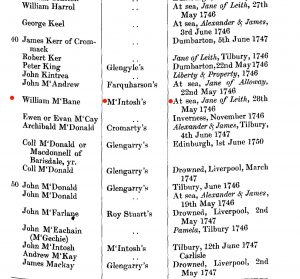 William McBane of the Macintosh Regt died en route Tilbury (Thames estuary) probably of wounds or typhus prior to transportation. This barely 2 months after Culloden. Starvation, disease, lack of clothes and lack of all medical aid was a policy designed to rid the Hanovarians of as many of their prisoners as possible. It is said that soldiers tasked with checking the prisoners refused to go below decks such was the stench of illness and filth. Those for interrogation who were too ill to walk were hoisted out of the holds in a bosun’s chair and sent below in the same manner.
William McBane of the Macintosh Regt died en route Tilbury (Thames estuary) probably of wounds or typhus prior to transportation. This barely 2 months after Culloden. Starvation, disease, lack of clothes and lack of all medical aid was a policy designed to rid the Hanovarians of as many of their prisoners as possible. It is said that soldiers tasked with checking the prisoners refused to go below decks such was the stench of illness and filth. Those for interrogation who were too ill to walk were hoisted out of the holds in a bosun’s chair and sent below in the same manner.
Scotland, Defending the Nation
Scotland, Defending the Nation
Very Interesting and likely superb second book by Christopher Fleet and the National Library of Scotland – ” Scotland, Defending the Nation.” – a book of military maps throughout the ages. For students of Culloden it includes the military map drawn up by a French Officer who fought at Culloden, and includes two manoevres by the Hanovarians, the reinforcement of their right wing, mid battle, and the flanking movement at the Culwhiniac Enclosure where Major Gillies ‘Mor’ MacBean fell mortally wounded. This map not published beforeRead More